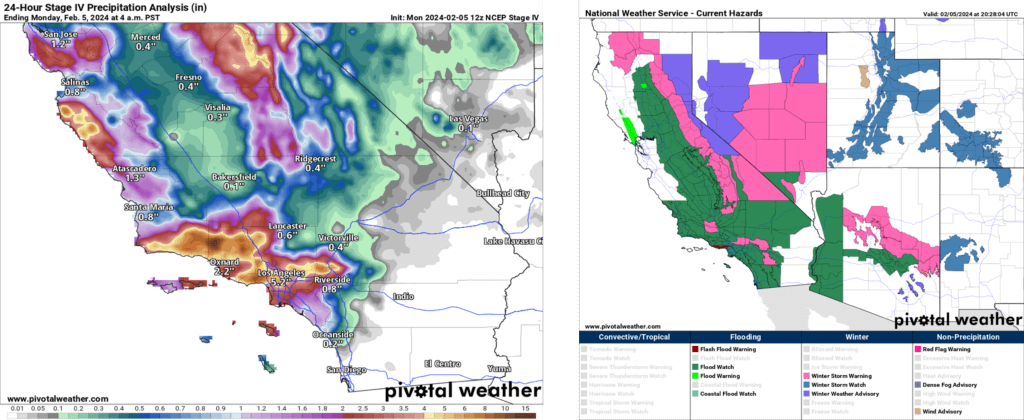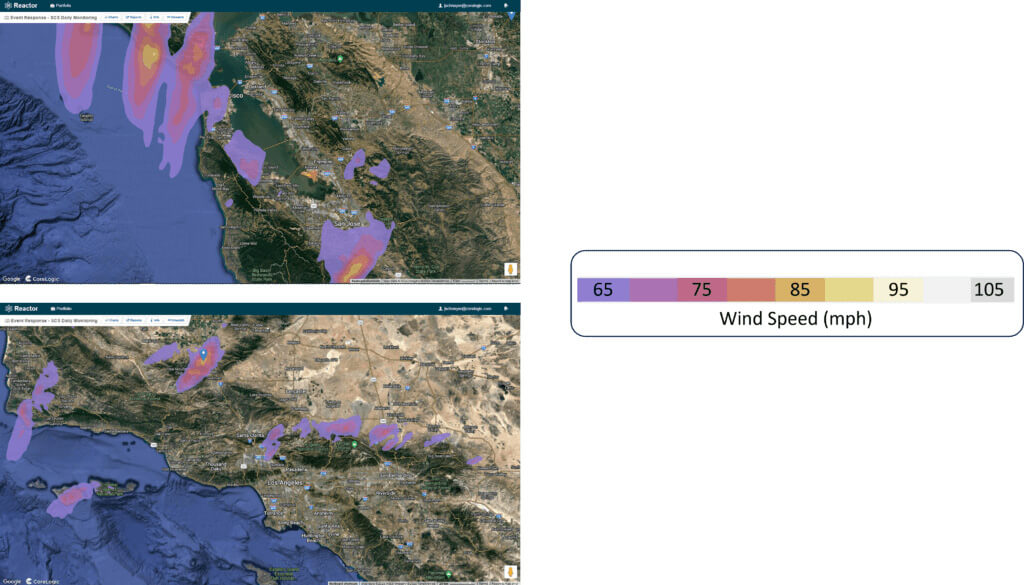More than 542,000 homes are at an elevated risk of flash flood damage near Los Angeles
Starting in early February, the U.S. West Coast experienced atmospheric river-related flooding similar to what occurred in the winter and spring of 2023. Hundreds of thousands of homes in California are at considerable risk of life-threatening flooding.
Weather stations across the state recorded extreme precipitation totals in Southern California. As of Feb. 5, there had been over 5 inches of rain in a 24-hour period in Los Angeles. Forecasts estimated that parts of the Los Angeles area may receive close to half a year’s worth of rain by Tuesday, Feb. 6. A flash flood warning was in effect for parts of California’s southern and central coastal region, including areas in Los Angeles (Figure 1).
Officials declared a state of emergency in eight California counties, with evacuations in some areas.

CoreLogic estimated that across the greater Los Angeles area, nearly 543,000 single- and multifamily homes with a combined reconstruction cost value (RCV) of more than $258 billion are at risk of flash flood damage.
Note, the reconstruction cost value in Table 1 does not represent a loss.
Reconstruction cost value is the cost to rebuild a property back to 100%, assuming complete destruction. Not all properties with elevated flash flood risk sustained flood damage. Any structures that were damaged may not have sustained 100% loss up to the full reconstruction value. The number of damaged properties will be a subset of the total 542,979 homes.
| CoreLogic Flash Flood Risk Score™ Rating | Number of Homes | Total Reconstruction Cost Value ($ billions) |
| Moderate | 402,959 | 195.5 |
| High | 83,717 | 38.8 |
| Very High | 47,378 | 20.7 |
| Extreme | 8,925 | 3.8 |
| Total | 542,979 | 258.7 |
Table 1: Number of residential properties and total reconstruction cost value (RCV) by Flash Flood Risk Rating
The CoreLogic Flash Flood Risk Score™ uses structure data available for the entire U.S. and watershed hydrology to extract hydrologic properties from land information datasets, incorporating probabilistic characteristics of meteorological factors to simulate precipitation impact. Flash flooding factors are then integrated to form an overall projection of flash flood risk for a specific structure or parcel.
An Explanation of Flash Flooding
Flash flooding occurs when precipitation rates are greater than the speed at which water drains into the ground surface. Several factors influence the ground surface penetration rates:
- The amount of impervious surface (e.g., pavement)
- Soil saturation
- Stormwater management system overwhelm
- Precipitation rates
In highly developed regions like the San Francisco Bay Area and Los Angeles area, water is unable to enter the ground and therefore flows over paved surfaces, flooding roads and sidewalks to create dangerous scenarios for travelers. In areas that are undeveloped, soil can saturate after prolonged rainfall. Saturated soil is unable to accommodate additional water, so rainfall pools on the surface and eventually becomes a flash flood. In the more mountainous regions of California, this can lead to mudslides.
CoreLogic Weather Verification™ Captures Hurricane-Force Gusts
In addition to heavy and intense rainfall, weather observation stations in the San Francisco Bay Area recorded hurricane-force wind gusts, which are capable of light to moderate property damage and severe infrastructure disruption, including widespread power outages.
More than 900,000 California power customers experienced outages as the heavy rain and intense winds battered the state. CoreLogic® Weather Verification Services (WVS) and the Reactor™ Platform captured the location of the strongest winds (Figure 2).

What is a Pineapple Express? What Are Atmospheric Rivers?
Atmospheric rivers transport moisture from the tropics to the mid-latitudes in long, narrow bands of water vapor. They account for most of the horizontal moisture transport in the atmosphere and can produce heavy rainfall and snowfall when they collide with landmasses.
Atmospheric rivers are typically 250 to 375 miles wide and 1,250 to 1,875 miles long and can carry a quantity of water equivalent to 15 Mississippi Rivers. These systems occur in both hemispheres and in all seasons, but they are more frequent and intense in the winter.
The Pineapple Express is one of the most well-known atmospheric rivers. It originates near Hawaii in the tropical Pacific Ocean and affects the West Coast of North America, especially California. Warm and moist air masses associated with the Pineapple Express can bring torrential rain and strong winds to the West Coast, sometimes causing floods, landslides, and mudslides. The Pineapple Express can also enhance the snowpack in the Sierra Nevada mountains, a vital source of water for California.
Some historical examples of atmospheric river flooding in the U.S. include:
- The Great Flood of 1862 submerged much of California’s Central Valley and turned it into an inland sea for several months.
- The Columbus Day Storm of 1962, the strongest extratropical cyclone on record in the Pacific Northwest, caused widespread damage and power outages.
- The New Year’s Day Flood of 1997 affected California, Nevada, and Oregon, causing more than $1 billion in damages and 17 deaths.
- The December 2007 Pacific Northwest storms brought record-breaking rainfall and wind gusts to Washington, Oregon, and northern California, triggering widespread flooding and landslides.
- The multiple rounds of atmospheric river-induced flooding in California in 2023 when flood waters breached the levee in Pajaro, California putting thousands of homes at risk.
CoreLogic Hazard HQ Command Central™ will continue to watch the atmospheric river flooding in California. More information may be provided if other data becomes available.
Contact: Please email [email protected] with questions about the atmospheric rivers, CoreLogic Flash Flood Risk Score™, the Reactor™ platform or any CoreLogic event response notifications. Visit www.hazardhq.com for updates and information on catastrophes across the globe.
©2024 CoreLogic, Inc. All rights reserved. The CoreLogic content and information in this blog post may not be reproduced or used in any form without express written permission. While all of the content and information in this blog post is believed to be accurate, the content and information is provided “as is” with no guarantee, representation, or warranty, express or implied, of any kind including but not limited to as to the merchantability, non-infringement of intellectual property rights, completeness, accuracy, applicability, or fitness, in connection with the content or information or the products referenced and assumes no responsibility or liability whatsoever for the content or information or the products referenced or any reliance thereon. Hazard HQ Command Central™, CoreLogic®, and the CoreLogic logo are the trademarks of CoreLogic, Inc. or its affiliates or subsidiaries. Other trade names or trademarks referenced are the property of their respective owners.


